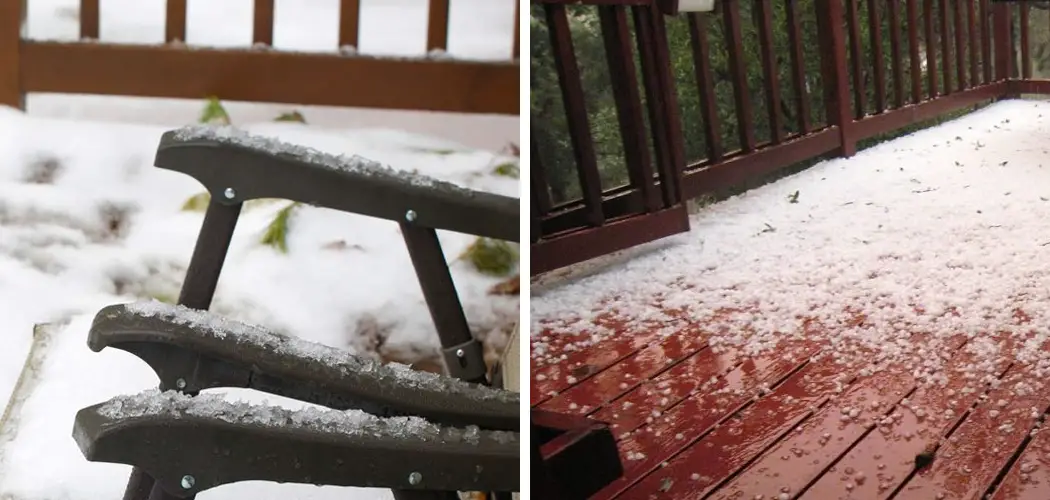Having a wood deck is a great way to enjoy the outdoors and appreciate your home. Unfortunately, when temperatures drop, water can accumulate on your wood deck and freeze into a hard layer of ice. This makes it incredibly difficult to remove the ice without risking damage to your wood deck in the process.
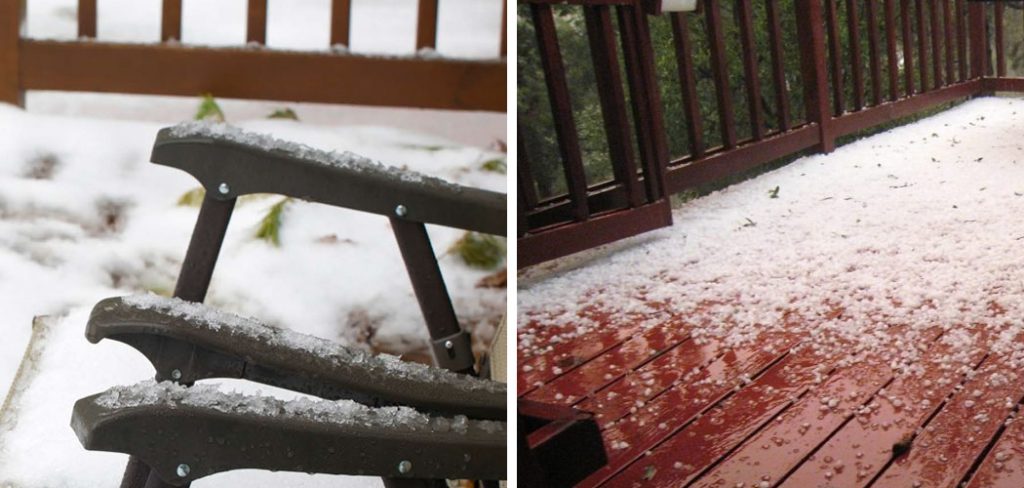
Fortunately, you can take steps to prevent your wood deck from icing over, which will help ensure that it remains looks its best in cold weather. One of the main advantages of preventing ice buildup on a wood deck is that it will help keep the deck safe and secure. Ice can cause slips and falls, so using methods like salt, sand, or kitty litter to treat icy patches will create a safer environment for your family and friends.
Additionally, these treatments also help prevent the wood deck from splintering and rotting, extending its life. Moreover, using treatments like salt can help reduce the ice on the deck and make it easier to shovel or sweep away when needed. In this blog post, You will learn in detail how to keep wood deck from icing.
Materials You Will Need
- Ice melt
- Shovel
- Broom
- Rake
- Plastic tarp
- Wooden stakes
- Hammer
- Push broom or snow blower
- Deck cleaner/protectant stain
- Extension cord (optional)
Step by Step Processes for How to Keep Wood Deck From Icing
Step 1: Inspect for any Existing Damage
Check the deck for any issues that need to be addressed before applying any anti-ice treatments. Look for loose boards, rot signs, wood cracks, or discoloration from mildew. If there is significant damage, these must be repaired first before attempting any preventative measures against icing.
Step 2: Pressure Wash
Pressure wash the wood deck with a cleaning product specifically formulated for wood decks. This will remove dirt, debris, mildew, and other contaminants that can trap moisture and cause damage to the wood.
Ensure all the water is completely cleared off the surface before continuing. If you’ve identified any cracks or other damage to the deck boards, use a caulking compound made for outdoor wood surfaces to fill them in. This will help keep moisture from getting into the cracks and causing further damage.
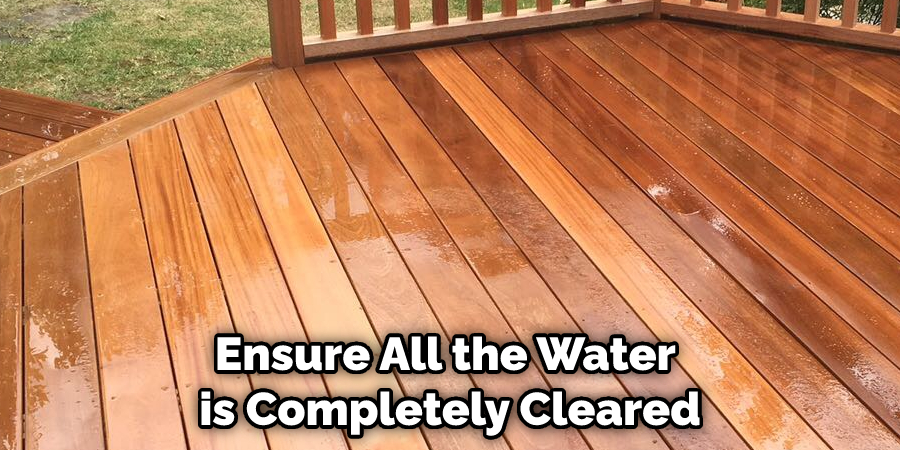
Step 3: Apply a Sealant
After cleaning and filling any existing cracks, apply a sealant to the deck surface. This will help protect the wood and prevent moisture from getting into the wood. In those areas where ice tends to form quickly, place shingle strips over the boards. These strips are waterproof and can be found at most hardware stores. They will help keep moisture out and limit the amount of ice that forms on the deck.
Step 4: Place Plastic Mats Over the Problem Areas
In those problem areas where there is still a tendency for ice to form, place plastic mats or runners over the deck boards. This will provide an extra layer of protection against moisture and keep ice from forming.
To help prevent ice from forming on the deck, apply an ice-melt compound to the surface. This will help absorb any moisture and keep it from freezing on the deck boards. Make sure to use a product that is specifically formulated for wood decks.
Step 5: Install Snow Guards
If you live in an area with a lot of snow, consider installing snow guards on your deck. These will help keep snow from piling up on the surface and melting down onto the wood boards. They also provide extra protection against ice forming on the deck. Ensure water drains from the deck and does not pool on the surface. If this is happening, it could cause ice to form more quickly.
Step 6: Monitor Regularly
Be sure to check your deck regularly for any signs of damage or moisture accumulation. Doing so will help ensure that your deck remains in good condition and is properly protected against icing.
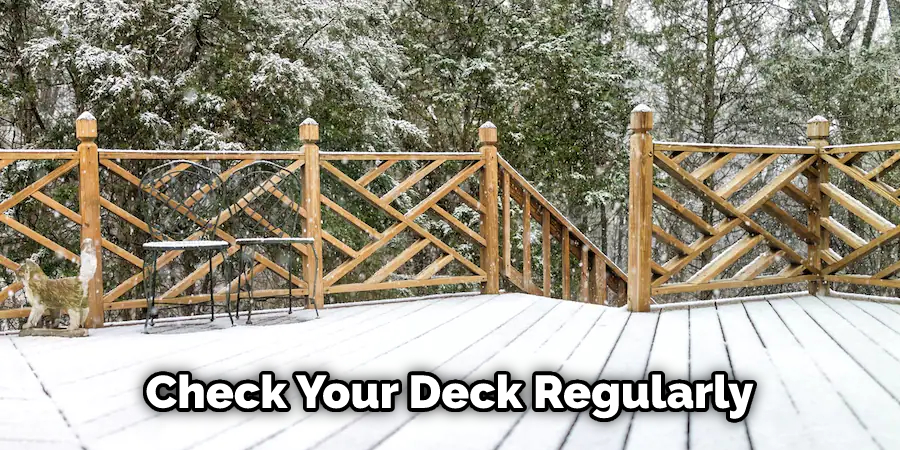
Following these steps, you can help keep your wood deck from icing over and protect it from further damage.
Precautions for How to Keep Wood Deck From Icing
- Ensure that boards are properly nailed down and that no loose or splintered pieces of wood exist, which can present a slipping hazard when wet. Also, ensure that any handrails are secure and in good condition.
- Keep your deck clean by regularly sweeping away leaves and other debris that can accumulate. This will help prevent the buildup of mold or mildew, which can cause damage to wood over time.
- Apply a sealant or protective coating to your deck to protect it from moisture and ice formation. Make sure to follow the manufacturer’s instructions for application and the recommended frequency for reapplication.
- Keep the temperature of your deck’s surface above 32 degrees Fahrenheit to prevent ice from forming. If you live in an area with colder winters, consider installing a portable heating device to keep your deck warm and safe for your family and guests.
- Using salt or other chemical agents to melt ice on your deck can actually do more harm than good. Not only does it cause damage to the wood, but it also increases the chances of slipping and falling due to its slippery nature.
- If you have no choice but to shovel snow from your deck, it’s important to invest in a good quality shovel that won’t damage the wood. A metal shovel should do the trick, but be sure to use it gently so as not to cause scratches or splinters.
- Consider wearing shoes with slip-resistant soles if you must walk on your deck during icy weather. Also, be sure to clear away any ice or snow before taking a step to reduce the chances of slipping and falling.

Following these precautions can help keep your wood deck safe from icing during cold weather. Taking the proper measures can help prevent accidents and preserve the life of your deck for years to come.
How Should You Store Any Winterizing Materials and Anti-icing Products When They Are Not in Use?
It is important to keep winterizing materials and anti-icing products stored properly when they are not in use. For example, any ice melts should be stored in a dry location and away from direct sunlight or heat sources, as this could cause the product to break down faster than originally anticipated. In addition, store any liquids or chemicals out of reach of children, pets, and wildlife to help prevent accidental ingestion or contact.
When it comes to winterizing your wood deck, safety is key. Make sure all materials are stored in a secure area away from heat or flame sources. This will help reduce the risk of fire hazards or other accidents caused by combustible materials.
Additionally, store any combustible materials in clearly labeled containers to help prevent misuse. Keeping your wood deck from icing is an important task. By following these simple steps, you can ensure the safety and longevity of your deck this winter season.
How Can You Prevent the Wood Deck From Becoming Slippery Due to Ice and Snow?
The best way to keep a wood deck from icing is to prevent ice and snow buildup in the first place. The most effective way to do this is by covering it with an appropriate roofing material, such as aluminum or steel. Additionally, you can add other materials, such as rubber mats, non-slip tape, or traction paint, for added grip and safety. Moreover, you can also remove ice and snow from the deck with a shovel or deicing product like rock salt.
Additionally, you can take preventative steps in the winter months to protect your wood deck from icing. Ensure that all your gutters are clean and free of debris to ensure that water is not pooling around the deck. Additionally, you can apply a sealant to the wood every year or two and ensure no cracks in your deck boards. Finally, keep ice-melting products away from your deck, as they can be corrosive to wood over time.
How Often Should You Inspect Your Wood Deck for Any Signs of Damage Related to Icing?
It is important to inspect your wood deck on a regular basis to identify any signs of damage related to icing or cold weather conditions. Cold temperatures and icing can cause wood boards to warp, twist, crack, split, and splinter. These damages can weaken the deck’s structural integrity and lead to costly repairs. Regular inspections allow you to identify and address potential issues before they become major problems.
Inspecting your wood deck during the winter season is especially important, as freezing temperatures and snow can lead to a buildup of ice on the deck surface. This ice can cause the boards to expand, leading to cracks, warps, or splinters in the wood. To prevent these issues from developing, inspect your deck for any signs of damage on a regular basis.
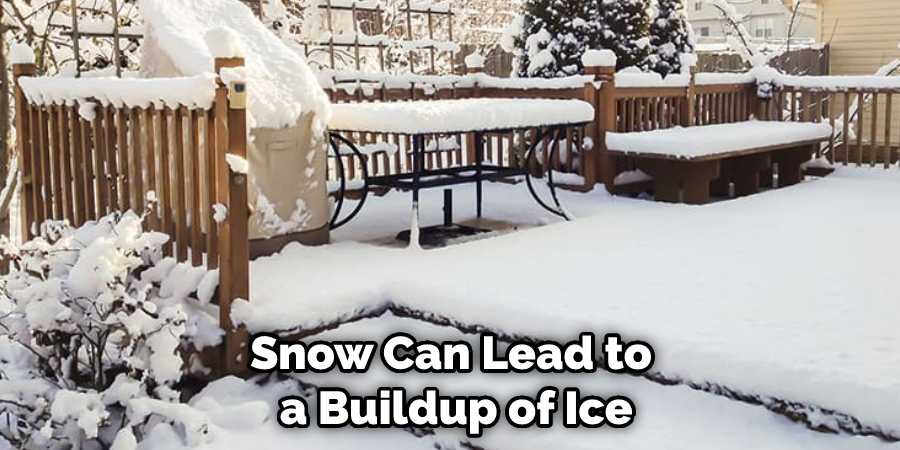
Conclusion
In conclusion, keeping a wood deck from icing can be difficult and time-consuming, but with the right materials and good maintenance practices, it is an achievable goal. Cleaning debris regularly and applying a protective sealant or coating to the wood surface are both key steps that should not be overlooked.
Additionally, clearing away snow and ice quickly when they appear on the deck will help prevent further damage and ensure that the deck remains safe throughout the winter. With these tips in mind, you can know that your wood deck is properly protected from ice this season. I hope reading this post has helped you learn how to keep wood deck from icing. Make sure the safety precautions are carried out in the order listed.
You Can Check It Out to Attach a Pergola to A Deck

